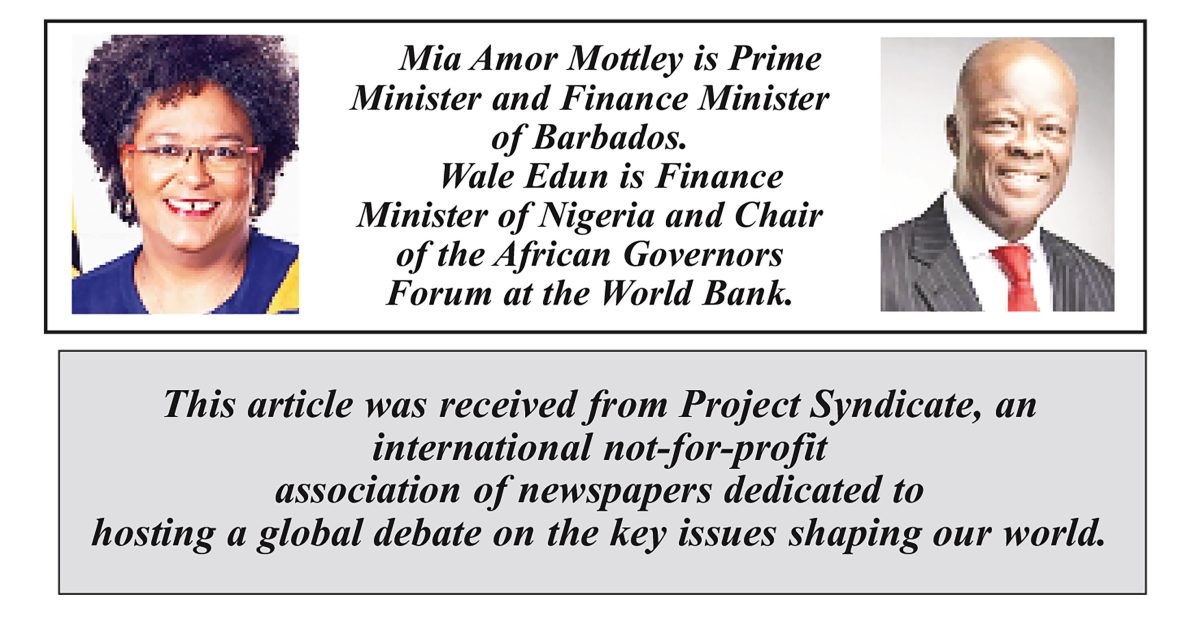BRIDGETOWN/ABUJA – A problem as unprecedentedly large and destructive as climate change demands bold new thinking and urgent action. Yet since the COVID-19 pandemic and Russia’s invasion of Ukraine, geopolitical tensions have dominated the global agenda, hindering collective efforts to address this existential challenge.
Anticipating what lay in store for their countries, African finance ministers came together during the pandemic to call for a $100 billion stimulus package to weather the shock. Four years later, however, net financial flows to developing countries have turned negative – meaning more money is being paid out to lenders in mostly rich countries than is coming in – owing to spiraling debt-service costs, higher interest rates, and the lack of additional external financing options. It is now crucial that existing pledges – such as the €150 billion ($160 billion) EU-Africa Global Gateway Investment Package – be implemented fully to support African countries.
US President Joe Biden and Kenyan President William Ruto acknowledged these challenges in their Nairobi-Washington Vision statement last month, when they committed to ensuring that “high ambition countries don’t have to choose between servicing their debts and making necessary investments in their futures.” The Biden administration recognizes that positive net financial flows are critical to supporting countries in responding to the climate crisis and building low-carbon energy systems.
As UN Secretary-General António Guterres recently reminded us, there is an 80% chance that the global average temperature will temporarily rise by more than 1.5° Celsius above pre-industrial levels in at least one of the next five years. The battle to keep global warming below the threshold established by the Paris climate agreement will be won or lost in the 2020s. The necessary investment and innovation needs to be happening now.
Countries like Nigeria and Sierra Leone are developing green growth plans and launching investment packages focused on renewables and climate-resilient infrastructure; and Barbados has just introduced its own 2035 investment plan to achieve prosperity and resilience. But these efforts all require financing.
The Bridgetown Initiative’s proposals for reforming the global financial architecture can drive the kinds of changes we need. The G20 has already responded by seeking a wealth tax that could unlock around $250 billion in new finance, and we could mobilize up to a trillion dollars more in low-cost lending by leveraging multilateral development banks’ (MDBs) balance sheets. Moreover, with climate clauses added to debt contracts, developing countries can preserve the fiscal space they need to respond to major climate shocks.
But we must do more. In May, the International Monetary Fund’s board approved the use of Special Drawing Rights (SDRs, the IMF’s unit of account) as hybrid capital, which will allow MDBs to expand their balance sheets. That is a good start, but G20 countries must commit the SDRs needed to capitalize on this financial innovation.
We also must ensure that concessional finance (loans with accommodative terms) continues to flow to the most vulnerable and climate-afflicted countries. One-third of the countries eligible for support from the World Bank’s International Development Association are now poorer than they were on the eve of the COVID-19 pandemic.
IDA countries have significant economic potential. They account for about 20% of global production of tin, copper, and gold; most are well-positioned to take advantage of solar energy (owing to abundant sunshine); and many possess deposits of minerals essential for the energy transition. But they are energy-poor and will need technical and financial support to provide electricity to 300 million people who lack it, as envisioned by a new program launched by the World Bank and the African Development Bank. To achieve an ambitious replenishment of the IDA fund later this year and unlock $120 billion in grants and loans to make this possible, World Bank shareholders must step up with new resources.
Middle-income countries – especially the Vulnerable 20 (which now includes 68 countries) – also urgently need more access to grants and long-term capital. Small island developing states should not be penalized for good performance by being forced to “graduate” from the IDA. That will put them at the mercy of capital markets when they still need quick, affordable finance to build resilience and maintain insurance against persistent climate shocks. The IMF’s Resilience and Sustainability Trust has demonstrated the necessary sensitivity toward vulnerable low- and middle-income countries’ need for long-term, affordable finance. But more of these kinds of facilities – and related mechanisms, like guarantees – are needed to accelerate progress over the coming decade.
We must continue to reduce the cost of capital for all countries seeking to invest in the energy transition. Our own countries face a premium when borrowing on capital markets, partly because credit rating agencies do not fully account for the conditions we face. The situation is not only unjust but also unwise. A good first step toward reducing borrowing costs and making investments commercially viable would be to reform IMF surcharges, which cost indebted borrower countries $1.9 billion in 2023 alone.
We also must continue to provide liquidity for developing countries through a new issuance of SDRs. This is a no-brainer, because it would stabilize currencies and help manage debt burdens without contributing to inflation. And finally, we must get carbon markets working to deter pollution and channel resources toward cleaner energy. Our collective stake in the planet’s future requires us to act both now and at scale.
Copyright: Project Syndicate, 2024.




